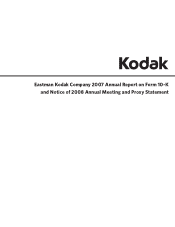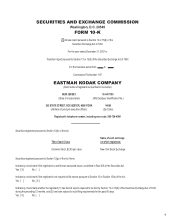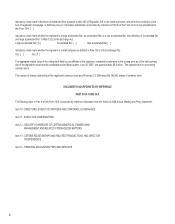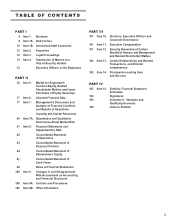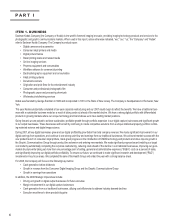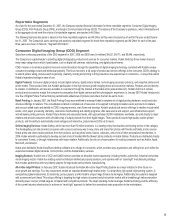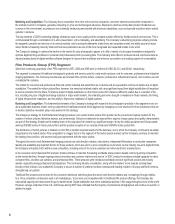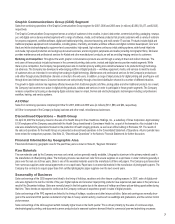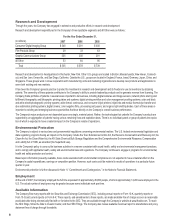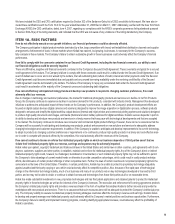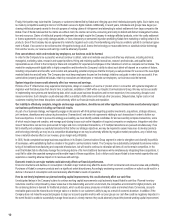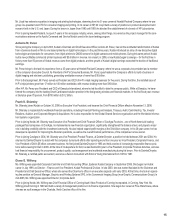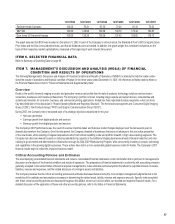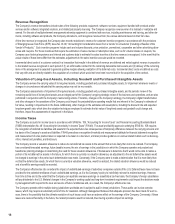Kodak 2007 Annual Report Download - page 11
Download and view the complete annual report
Please find page 11 of the 2007 Kodak annual report below. You can navigate through the pages in the report by either clicking on the pages listed below, or by using the keyword search tool below to find specific information within the annual report.10
Finally, third parties may claim that the Company or customers indemnified by Kodak are infringing upon their intellectual property rights. Such claims may
be made by competitors seeking to block or limit Kodak’s access to digital markets. Additionally, in recent years, individuals and groups have begun pur-
chasing intellectual property assets for the sole purpose of making claims of infringement and attempting to extract settlements from large companies like
Kodak. Even if Kodak believes that the claims are without merit, the claims can be time-consuming and costly to defend and distract management’s atten-
tion and resources. Claims of intellectual property infringement also might require the Company to redesign affected products, enter into costly settlement
or license agreements or pay costly damage awards, or face a temporary or permanent injunction prohibiting Kodak from marketing or selling certain of its
products. Even if the Company has an agreement to indemnify it against such costs, the indemnifying party may be unable to uphold its contractual agree-
ment to Kodak. If we cannot or do not license the infringed technology at all, license the technology on reasonable terms or substitute similar technology
from another source, our revenue and earnings could be adversely impacted.
If we cannot attract, retain and motivate key employees, our business could be harmed.
In order for the Company to be successful, we must continue to attract, retain and motivate executives and other key employees, including technical,
managerial, marketing, sales, research and support positions. Hiring and retaining qualified executives, research professionals, and qualified sales
representatives are critical to the Company’s future and competition for experienced employees in the industries in which we compete can be intense. The
market for employees with digital skills is highly competitive and therefore the Company’s ability to attract such talent will depend on a number of factors,
including compensation and benefits, work location and persuading potential employees that the Company is well-positioned for success in the new digital
markets Kodak has and will enter. The Company also must keep employees focused on the strategic initiatives and goals in order to be successful. If we
cannot attract properly qualified individuals, retain key executives and employees or motivate our employees, our business could be harmed.
System integration issues could adversely affect our revenue and earnings.
Portions of our IT infrastructure may experience interruptions, delays or cessations of service or product errors in connection with systems integration or
migration work that takes place from time to time; in particular, installation of SAP within our Graphic Communications Group. We may not be successful
in implementing new systems and transitioning data, which could cause business disruptions and be more expensive, time consuming, disruptive and
resource-intensive. Such disruption could adversely affect our ability to fulfill orders and interrupt other processes. Delayed sales, higher costs or lost
customers resulting from these disruptions could adversely affect our financial results and reputation.
Our inability to effectively complete, integrate and manage acquisitions, divestitures and other significant transactions could adversely impact
our business performance including our financial results.
As part of our business strategy, we frequently engage in discussions with third parties regarding possible investments, acquisitions, strategic alliances,
joint ventures, divestitures and outsourcing transactions (“transactions”) and enter into agreements relating to such transactions in order to further our
business objectives. In order to pursue this strategy successfully, we must identify suitable candidates for and successfully complete transactions, some
of which may be large and complex, and manage post-closing issues such as the integration of acquired companies or employees. Integration and other
risks of transactions can be more pronounced for larger and more complicated transactions, or if multiple transactions are pursued simultaneously. If we
fail to identify and complete successfully transactions that further our strategic objectives, we may be required to expend resources to develop products
and technology internally, we may be at a competitive disadvantage or we may be adversely affected by negative market perceptions, any of which may
have a material adverse effect on our revenue, gross margin and profitability.
In 2005, Kodak completed two large business acquisitions in its Graphic Communications Group segment in order to strengthen and diversify its portfolio
of businesses, while establishing itself as a leader in the graphic communications market. The Company has substantially completed its extensive restruc-
turing of its traditional manufacturing and corporate infrastructure, but will need to continue to rationalize all items of cost to remain competitive. In the
event that Kodak fails to effectively manage the continuing decline of its more traditional businesses while simultaneously integrating these acquisitions, it
could fail to obtain the expected synergies and favorable impact of these acquisitions. Such a failure could cause Kodak to lose market opportunities and
experience a resulting adverse impact on its revenues and earnings.
Economic trends in our major markets could adversely affect our financial performance.
Economic downturns and declines in consumption in Kodak’s major markets may affect the levels of both commercial and consumer sales and profitability.
Purchases of Kodak’s consumer products are to a significant extent discretionary. Accordingly, weakening economic conditions or outlook could result in a
decline in the level of consumption and could adversely affect Kodak’s results of operations.
If we do not timely implement our planned working capital improvements, this could adversely affect our cash flow.
Unanticipated delays in the Company’s plans to continue working capital improvements could adversely impact Kodak’s cash flow. Planned inventory
reductions could be compromised by slower sales due to the deteriorating economic environment, the competitive environment for digital products, and
the continuing decline in demand for traditional products, which could also place pressures on Kodak’s sales and market share. Conversely, accounts
receivable goals could be missed due to stronger sales or a decline in our customers’ ability to pay as a result of economic downturn. In addition, if the
Company does not make the expected progress to align our accounts payable metrics with our peer groups our cash flow could be negatively impacted. In
the event Kodak is unable to successfully manage these issues in a timely manner, they could adversely impact the planned working capital improvement.

